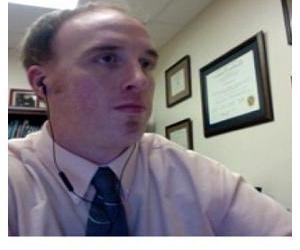
Gary Miller sees sustainability as Maricopa Unified School District’s No. 1 challenge and reducing costs as the key to improving school letter grades. Miller is one of five candidates for two seats on the school board.
Age: 41
Family: Wife Jolene, two boys in third and fourth grade, two foster children in second and fifth grade.
Education: I earned a bachelor degree in political science from the University of Kansas and graduated Magna Cum Laude from my master’s degree program in social work from Washburn University. After earning my master’s degree, I graduated Summa Cum Laude from ASU in 2012, earning a doctor of behavioral health degree.
Occupation: Health information technology consultant and principal of pro-bono national research project.
School kids attend: Pathway; foster kids attend Butterfield
Hobbies: Traveling, college basketball, studying Shin-Shin Toitsu Aikido.
Community service: I serve on the City of Maricopa Board of Adjustments and chair the Pinal County Republican Club Teenage Republicans. I currently facilitate a community foster care support group for parent resource providers.
Maricopa resident since: 2005
Why are you running?
My motivation derives from a desire to measure and improve outcomes for our school system as much as possible by focusing on the “A” solutions while addressing the district's financial problems, to retain quality teachers, and to be involved with the district while I have school-aged children.
What qualifies you for the position?
The fundamental responsibility of a governing board member is to balance the budget, create policy and manage the superintendent. My conservative framework will help guide me to balance the budget. My background and education in public policy, healthcare, research, quality control, community outreach and prior board experience will indeed add value to the MUSD 20 Governing Board that will enable me to help measure outcomes and improve the district’s overall letter grade.
What do you hope to accomplish during your term?
I follow Pareto’s Principle (80/20 Rule), that 80 percent of the effect is produced by the vital few 20 percent of the causes. I believe increasing access and develop a continuous quality improvement plan are the two causes within my professional competence that will help produce the greatest effect for a more sustainable MUSD 20. I hope to improve MUSD 20 strategies and/or policy that will help remove institutional barriers to academic success as well as putting more dollars in the classroom versus the administration.
How will you accomplish that?
I believe that the ideal solution is to increase access and quality management to reduce the costs associated with the operation of MUSD 20 that will naturally improve the district wide letter grades. I will help to improve student access to adequate healthcare and social services, transportation, technology that includes assistive technology, individualized education programs, honors courses and will never vote against access to all day kindergarten. I also value and support access to after school academic and athletic activities that are prevention interventions to help curve teen pregnancy, truancy and the student dropout rate.***ADVERTISEMENT***
What are the three biggest challenges facing MUSD?
1. Sustainability of MUSD 20 over time.
2. Ratio of dollars spent in the classroom.
3. Access.
What will you do to overcome them?
We need to continue and build our culture and tradition(s) within MUSD 20 on many levels so that there is not a disconnect between the administration, teachers, staff, students, their family and the community as well as our community. I believe continuous quality control (CQI) will help guide the district to better manage the flow of operation for a more sustainable future.
Do you support MUSD’s effort to pass a budget override?
I do support the budget override. The money will be spent in the classroom and in return will help reduce class size. The surgeon general reports that 1 in 5 youth experience a mental health condition, so I calculated the ratio of students per classroom that experience a mental health “condition” in each MUSD 20 school. Reducing the ratio of students per classroom will naturally reduce the average number of students per classroom that experience a mental health condition.
Click here to access Q&As from other school board candidates.


![Who’s the Best Mom InMaricopa? Nominate now! Marlene Marshall, Christina Olivares, and Meghan Bremer. [Bryan Mordt]](https://www.inmaricopa.com/wp-content/uploads/2023/05/BCM_8465-218x150.jpg)



![Maricopa sheds tears amid Maui wildfires that killed dozens For Maricopa resident Janelle Gomez, the sorrow mirrors the loss of a family member. [Brian Petersheim]](https://www.inmaricopa.com/wp-content/uploads/2023/08/Gomez-218x150.jpg)
![Embracing Freedom: Celebrating the Fourth of July Councilmember Vincent Manfredi at Great American 4th 2021 [Victor Moreno]](https://www.inmaricopa.com/wp-content/uploads/2023/07/2021-Great-American-4th-e1688414543522-218x150.jpg)




![Alleged car thief released without charges Phoenix police stop a stolen vehicle on April 20, 2024. [Facebook]](https://www.inmaricopa.com/wp-content/uploads/2024/04/IMG_5040-218x150.jpg)

![City gave new manager big low-interest home loan City Manager Ben Bitter speaks during a Chamber of Commerce event at Global Water Resources on April 11, 2024. Bitter discussed the current state of economic development in Maricopa, as well as hinting at lowering property tax rates again. [Monica D. Spencer]](https://www.inmaricopa.com/wp-content/uploads/2024/04/spencer-041124-ben-bitter-chamber-property-taxes-web-100x70.jpg)

![3 things to know about the new city budget Vice Mayor Amber Liermann and Councilmember Eric Goettl review parts of the city's 2024 operational budget with Mayor Nancy Smith on April 24, 2024. [Monica D. Spencer]](https://www.inmaricopa.com/wp-content/uploads/2024/04/spencer-042424-preliminary-budget-meeting-web-100x70.jpg)
